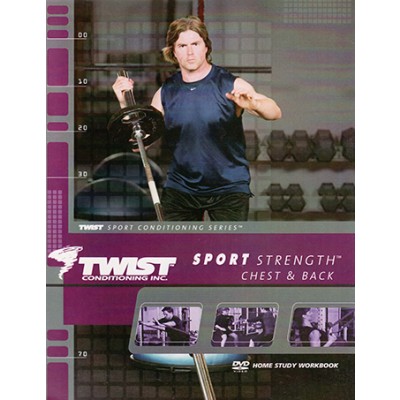
Sport Strength: Chest and Back
SKU: 807
By Peter, Twist, B.PE, MPE, CSCS
Twist Conditioning has built its own unique system of training. The Twist Training paradigm focuses on training movement, not muscle. The system helps athletes to develop efficient, quick, powerful, deceptive, and confident movement abilities that will translate into increased sport skills, tactics, and overall performance. This method has developed and evolved through years of practical experience and sport science research. Traditional methods of training, such as muscle isolation, machine-based training, aerobic training, and linear speed training can all lead to injury and leave the body ill-prepared for the demands of sport and life.
The Twist Sport Conditioning Paradigm draws upon the secondary fitness characteristics: anaerobic energetics, dynamic balance, speed, agility, quickness, multi-directional movement skills, muscle reactivity, joint stability, whole body reaction skills, multi-joint strength, whole-body power initiation, rotary core power, deceleration and other athletic attributes that contribute to making athletes more skillful and durable.
Course Length: 4.0 contact hours
Instructional Level: Beginner/Intermediate
This package contains the Sport Strength: Chest and Back workbook and DVD.
Sorry, but this course is not available as an online course
Sport Strength: Chest and Back
Goals and Objectives:
Course Goals: This course is intended to instruct the student through self-paced study, on ways to improve their competence in the field of sport conditioning by developing competence in the Twist Sport Strength: Chest and Back training methodology.
Student Objectives:
At the end of this course, the student will be able to:
1. Identify the prime motive for athletes in terms of strength.
2. Identify 5 attributes of sport that can be improved with Linked Strength TM training.
3. Identify 8 training concepts incorporated into the Linked Strength TM training program.
4. Identify 6 sport requirements that should be assessed when treating or training an athlete.
5. Identify 8 variables that can be manipulated to achieve progressive overload when building strength and power.
6. Identify neural complexity.
7. Identify eccentric loading.
8. Identify the 4 major attributes of your athletes that you should consider when developing a training program.
9. Identify 3 reasons why a warm-up is critical.
10. Identify 4 things to consider when planning and preparing your workout.
11. Identify 27 exercises for strengthening of the chest and back using BOSU TM, stability balls, Olympic bars, dumbbells, balance boards and tubing and ways to modify the exercises for skill level.
12. Identify 4 things that can be increased to achieve the overload principle.
13. Identify hypertrophy.
14. Identify relative strength.
15. Identify sequential firing.
16. Identify reactivity.
17. Identify the key ingredient in the recipe for successful training.
18. Identify 7 criteria that can be used to determine if an exercise is "athlete ready"
SKU: 807
By Peter, Twist, B.PE, MPE, CSCS
Twist Conditioning has built its own unique system of training. The Twist Training paradigm focuses on training movement, not muscle. The system helps athletes to develop efficient, quick, powerful, deceptive, and confident movement abilities that will translate into increased sport skills, tactics, and overall performance. This method has developed and evolved through years of practical experience and sport science research. Traditional methods of training, such as muscle isolation, machine-based training, aerobic training, and linear speed training can all lead to injury and leave the body ill-prepared for the demands of sport and life.
The Twist Sport Conditioning Paradigm draws upon the secondary fitness characteristics: anaerobic energetics, dynamic balance, speed, agility, quickness, multi-directional movement skills, muscle reactivity, joint stability, whole body reaction skills, multi-joint strength, whole-body power initiation, rotary core power, deceleration and other athletic attributes that contribute to making athletes more skillful and durable.
Course Length: 4.0 contact hours
Instructional Level: Beginner/Intermediate
This package contains the Sport Strength: Chest and Back workbook and DVD.
Sorry, but this course is not available as an online course
Sport Strength: Chest and Back
Goals and Objectives:
Course Goals: This course is intended to instruct the student through self-paced study, on ways to improve their competence in the field of sport conditioning by developing competence in the Twist Sport Strength: Chest and Back training methodology.
Student Objectives:
At the end of this course, the student will be able to:
1. Identify the prime motive for athletes in terms of strength.
2. Identify 5 attributes of sport that can be improved with Linked Strength TM training.
3. Identify 8 training concepts incorporated into the Linked Strength TM training program.
4. Identify 6 sport requirements that should be assessed when treating or training an athlete.
5. Identify 8 variables that can be manipulated to achieve progressive overload when building strength and power.
6. Identify neural complexity.
7. Identify eccentric loading.
8. Identify the 4 major attributes of your athletes that you should consider when developing a training program.
9. Identify 3 reasons why a warm-up is critical.
10. Identify 4 things to consider when planning and preparing your workout.
11. Identify 27 exercises for strengthening of the chest and back using BOSU TM, stability balls, Olympic bars, dumbbells, balance boards and tubing and ways to modify the exercises for skill level.
12. Identify 4 things that can be increased to achieve the overload principle.
13. Identify hypertrophy.
14. Identify relative strength.
15. Identify sequential firing.
16. Identify reactivity.
17. Identify the key ingredient in the recipe for successful training.
18. Identify 7 criteria that can be used to determine if an exercise is "athlete ready"

